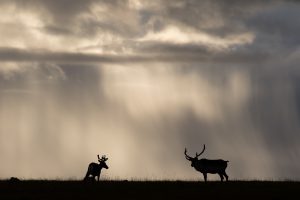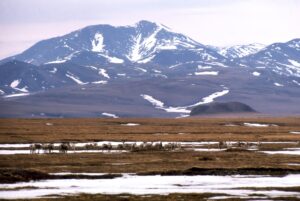Since 1991, Yellowknife-based journalist Laurie Sarkadi has lived and raised a family in the wilderness just outside the Northwest Territories capital in a home completely independent of services like water, power or sewer lines. It’s a challenging lifestyle where temperatures below -40 C can freeze vehicles, pipes and the solar-powered battery bank her home depends on for power. But it also imparts a special communion with creatures living in the surrounding boreal ecosystem, including caribou.
Canadian Geographic has been shining a spotlight recently on the realistic possibility that Canada’s once-thundering caribou herds are nearing extinction. In 2007, around when the precipitous fall began, we deemed the decline of barren-ground caribou herds our Wildlife Story of the Year and assigned Sarkadi to write about them. Some of her resulting feature became part of Voice in the Wild, her memoir, available now from Caitlin Press. Here’s an excerpt from the book, which paints a scene from Oct. 26, 1992, when the Bathurst caribou herd migrated past her home. Survey results released Nov. 20 by the Government of the Northwest Territories show the herd has declined to about 8,200 animals, a staggering decline from its peak of 470,000 in 1986.
My son Max is a babe in arms when the caribou arrive unhurried and unannounced on our frozen lake. First in small groups, then swelling into hundreds, then thousands, their leggy, silver-brown bodies move like puffs of campfire smoke in the morning fog; their sharp-edged hooves dig into ice like teeth into a snow cone.
Perhaps it’s the caribou’s giving nature, perhaps they don’t know to distrust us, but as we stand awestruck amongst them, they soldier past with minimal wariness, unfazed as well by the steady crack of nearby gunfire.
Some Aboriginal people credit their very existence to the abundant charity of the herd.
It’s an unprecedented slaughter. Never before have the caribou made themselves so accessible to nearly 20,000 people in the territorial capital. Just a 30-minute drive outside of Yellowknife, Dene and non-Aboriginal hunters turn the snowy white landscape into a bloodied killing field. With wanton disregard, some hack off only choice parts of meat, leaving near-whole carcasses to waste and rot.
Before there were high-powered rifles and pickup trucks, when circumpolar peoples followed the herds by canoe and dog-team into the Barrenlands to survive, it was believed caribou offered their entire beings for food, shelter and clothing in return for respect and good behaviour. Clearly today, that agreement is being breached.
The Bathurst herd is an estimated 350,000 strong on Oct. 26, 1992. While I had witnessed the teeming migration of wildebeest and impala along the Serengeti plains of Africa, like most Canadians, I’d scarcely been aware North America still had spectacular, and indeed larger, movements of wild animals. We’d killed off the buffalo of the Great Plains, but the sheer cold and rigours of Arctic terrain had so far shielded the caribou from a similar plight.
The caribou’s annual migration from the tundra to their wintering grounds on the north shore of Great Slave Lake—earlier, and farther south and west than usual—alerts me to their journey and in some ways awakens me to mine. As a new mother, I’m shedding parts of my old self, pulsing with new blood and expanded awareness, like the budding antlers that crown the caribou each year, never growing to maturity in the same way twice.
Caribou are unique amongst deer in that females have antlers. Female antlers develop from June to September and are retained throughout winter to defend cratered feeding spots in the snow from older males, who drop their antlers after the fall rut. This provides a survival advantage for the female and her calf.
The herd largely disperses over the winter, but occasionally, some make stirring appearances, like the lone female that stands outside my house the day my friend Jeanette’s mother dies.
For 10 years, Jeanette had lived alone in her A-frame log cabin a few kilometres past our house, but at the time of her mother’s death, she lived with her roommate France, one lake down the highway from us. I met them both at a gathering of ecologically minded people in a room filled with baked goods and talk of good deeds that need doing. My herd of friends was changing, branching out from mostly media types. Jeanette was a psychiatric nurse who worked as an addictions counsellor for youth. She also had no hip joints.
It feels blasphemous to introduce Jeanette by her handicap, given the depths of her strength and fortitude, not to mention her wholesome, short-haired attractiveness, all of which made much more lasting impressions on me during the years of our friendship than the click of her cane and her lopsided gait, the result of a genetic bone condition that precipitated two failed hip replacements and robbed her at age 12 of the chance to defend her title of fastest girl in school. This could also explain why I think of Jeanette as being tall, with her long limbs and big feet and hands, when in fact she’s not.
Caribou have slender “deer-type” legs but much broader and flexible feet to facilitate walking on snow and ice. The feet make a clicking sound while walking—a noise produced by a tendon slipping over the sesamoid bone in the foot.
And yet Jeanette’s physical challenges are significant given the rugged lifestyle she’s chosen, living alone in the bush without a continuous power source or flush toilet; heating her log cabin by wood that she chops and carries herself; hauling her water from town in big heavy jugs—all testimony to her strong will and deep affinity for nature.
On Jan. 7, 1993, Jeanette awoke to a temperature of -45 C after receiving a phone call the night before that her mother wasn’t expected to live through the night. The diesel generator that powered the house she shared with France wouldn’t turn over, which meant there was no power to plug in her car to heat its battery and engine. The battery bank that provided alternative power sat dead in the extreme chill of their front entrance—which meant there was no power for the phone. France’s car was in their garage and sputtered to life. They rode to town together so Jeanette could be updated on her mother’s condition.
Her mother died later that morning, alone in a faraway hospital. France picked Jeanette up to bring her back home, only to learn the house problems hadn’t yet been rectified. So in those numbing first few hours of reconciling her motherless existence, Jeanette arrived at my door. I didn’t know her well then and didn’t feel qualified to deal with her grief, which manifested in quiet contemplation, likely shock, instead of tears. There was the requisite tea and soft-spoken inquiries, then a call from France saying the house was repaired and Jeanette could now work the phones from home.
I went to the garage to start my car, only to realize Francois had taken it to work because his truck had also frozen. I suggested to Jeanette that I put Max in my amautiq and accompany her on the twenty-minute, mostly downhill, walk to her house. Perhaps because I didn’t think of her as handicapped, I didn’t fully appreciate the difficulties this could entail for her. We bundled up and stepped outside.
Everywhere was white light. The sun ricocheted off fresh snow that coated the landscape like a jug of spilled milk. Glassy hoarfrost wrapped itself around every needle and branch of the forest. Our entire surroundings—highway, lake, rock and trees—glittered as if a giant disco ball spun above us in the crisp blue sky. We took a few steps then simultaneously stopped to drink in the view a bit longer. The stillness was electrifying; nothing moved except the Arctic cold that circled our breath, turning each exhale into puffs of vapour. That’s when I noticed her, the lone caribou staring plaintively at us, just a few metres away in the direction we were heading.
Some Inuit believe when a caribou comes very close to a community, it is a relative coming to visit and it should not be harvested.
This timely visit boosted our spirits and heightened our senses, although years later when I discuss that day with Jeanette she has little recollection of the caribou, but remembers how the bracing cold and the migration to her house had grounded her and how Max’s soft brown eyes watched her from the back of my coat. She does, however, recall a dream she had some time afterward in which she was moving down our road and a large caribou jumped in front of her face. She awoke with a start knowing instantly the caribou had been her mother—the one and only time she ever felt her mom’s presence after she died. We’d picked our way carefully, and very slowly, over the icy highway on that day, me with my precious cargo, Jeanette with her heavy heart.
According to Inuit Qaujimajatuqangit (What has always been known), when people cut themselves, they would use the dried up outer covering of the caribou heart as a bandage because it does not leak …
Laurie Sarkadi is an award-winning writer, producer and editor. She moved to Yellowknife as the Edmonton Journal
’s northern bureau chief then spent 16 years telling northerners’ stories through CBC radio and television. Voice in the Wild
is her first book. She lives off-grid in the Northwest Territories.




